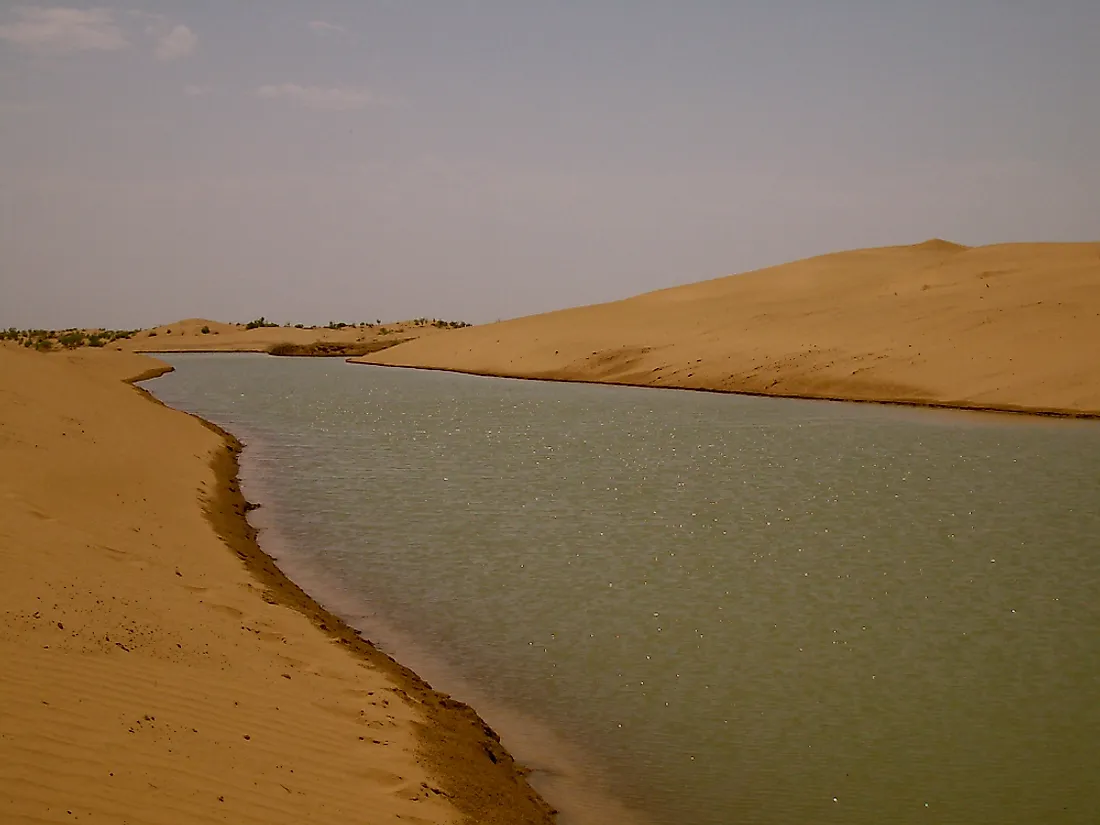The Karakum Canal in Turkmenistan

The Karakum Desert is located in Turkmenistan, Central Asia. Its name is derived from the two Turkic words "Kara Kum," which means Black Sand. The desert covers an area of about 135,000 square miles which is about 70% of Turkmenistan's land area.
The Karakum desert is one of the driest places on earth. However, there is surface water running across this desert in the form of the 850-mile Karakum Canal. First constructed in 1954 during the Soviet era, the Karakum Canal is one of the largest desert irrigation projects in the world. The water source of the canal comes from the Amu Darya River, which is fed by the rivers of its neighbor country, Uzbekistan. This canal carries the water deep into the desert irrigating about 3,800 square miles of land planted with crops and an additional 13,500 square miles of open land. Although the Karakum Canal has brought water to most parts of the desert, it has also brought disastrous salinization to 73% of the arable land in the area. This situation has also waterlogged the same desert land which is due to the unlined Karakum canal leaking water along its path.
Brief History
The Karakum Desert has a topography that is mostly rugged plains alternating with dunes and sandy ridges. Plateaus, lowlands, and plains that reach the mountain foothills divide the landscape. The sparsely populated desert has a population density of about one Turkmen per 2.5 square miles. The ancient settlers of the desert have always been nomadic and depended on the Amu Darya River and the Caspian Sea for their sustenance. In the inner areas of the desert, the early inhabitants dug deep wells to access the underground water. Another water source was rain collection areas they developed in the region.
As early as the 18th century, the Russian government has sent teams of archaeologists, geologists and scientists to explore the Karakum area. Archaeological explorations in the 1940s to the 50s revealed Stone Age and Bronze Age cultures in the Dzheytun region. The discovery of ancient settlements and cities in the Ashgabat area has created interests in antiquities from the Ancient Parthian city of Nisa. Over hundreds of years, desertification took over the area and the consequence has resulted in today's Karakum desert. During the Soviet era, the area was under a master plan proposed by the Soviet government for water resources improvement. The Karakum Canal became functional in 1987 delivering water to the southern oases and the capital city of Ashgabat.
The Need for Water
Water-stressed countries in Central Asia has become the norm today after the dissolution of the Soviet Union. In the early 1950s, Turkmenistan was plagued with a lack of water. The Karakum desert was waterless during that time. Today, the area has too much water, creating a waterlogged arable land with an undesirable high salinity content. The inhabitants of the Karakum who live in small farms and towns in the desert complete with modern conveniences today have tried to reverse this soil salinity by constructing drainage systems that direct the salty water away from the croplands. As a result, fodder crops, cotton, fruits, and vegetables have been successfully grown in the area. Since the end of World War II, the Karakum area has received a sizable economic growth. The discovery and mining of mineral salts and sulfur deposits encouraged migration to the area. Construction of highways and railroads has brought factories, thermal power plants, and hydroelectric power stations. The additional laying of gas and oil pipelines has also brought economic prosperity to the area and contributed to the economy of the country. In 2015, President Berdymukhammedov declared “A Drop of Water – a Grain of Gold” national holiday to help make people aware of the value of water that their ancestors had respected and known. He also added that the government would make significant improvements to the current water delivery system in the country.











